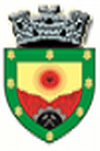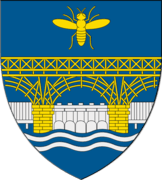Baia de Aramă
| Baia de Aramă | ||
|---|---|---|
| Town | ||
| ||
 Baia de Aramă Location of Baia de Aramă | ||
| Coordinates: 45°0′0″N 22°48′41″E / 45.00000°N 22.81139°ECoordinates: 45°0′0″N 22°48′41″E / 45.00000°N 22.81139°E | ||
| Country |
| |
| County | Mehedinți County | |
| Status | Town | |
| Government | ||
| • Mayor | Rafael Dunarintu (Social Democratic Party) | |
| Population (2011) | ||
| • Total | 5,349 | |
| Time zone | EET (UTC+2) | |
| • Summer (DST) | EEST (UTC+3) | |
| Climate | Cfb | |
| Historical population | ||
|---|---|---|
| Year | Pop. | ±% |
| 1910 | 1,490 | — |
| 1930 | 1,461 | −1.9% |
| 1948 | 1,513 | +3.6% |
| 1977 | 4,899 | +223.8% |
| 1992 | 5,624 | +14.8% |
| 2002 | 5,724 | +1.8% |
| 2011 | 5,349 | −6.6% |
| Source: Census data | ||
Baia de Aramă is a small Romanian town located in Mehedinţi County, in the historical region of Oltenia, with a population of 5,724. The Brebina River runs through the town. Some Dacian ruins can be found in the town, as well as the 17th century Baia de Aramă Monastery .
The name of the town means "copper mine", suggesting that Baia de Aramă was once a strong copper mining town. However, over the years, many of the mines in the town have closed, leaving roughly half the town unemployed.
Eight villages are administered by the town: Bratilovu, Brebina, Dealu Mare, Mărăşeşti, Negoeşti, Pistriţa, Stăneşti and Titerleşti.
| Wikimedia Commons has media related to Baia de Aramă. |
This article is issued from Wikipedia - version of the 7/22/2016. The text is available under the Creative Commons Attribution/Share Alike but additional terms may apply for the media files.

